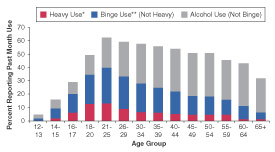Past Month Alcohol Use
In 2000, 47 percent of Americans aged 12 or older (approximately 104 million people) indicated that they had used alcohol during the month prior to the survey, including 21 percent (46 million people) who reported binge drinking and 6 percent (almost 13 million people) who reported heavy drinking. Rates of past month alcohol use increased with increasing age during youth and young adulthood, from 2 percent at age 12 to a peak of 65 percent at age 21. The highest rates of both binge and heavy drinking were for young adults aged 21 to 25 (Figure 1), with the peak rate occurring at age 21 (45 percent binge drinking and 17 percent heavy drinking). Binge and heavy alcohol use rates decreased faster with age than did rates of past month alcohol use.
Underage Alcohol Use
Nearly 10 million people aged 12 to 20 (28 percent of this age group) reported drinking alcohol in the month prior to the 2000 survey. Of those individuals, almost 7 million (19 percent) were binge drinkers and 2 million (6 percent) were heavy drinkers. Combined 1999 and 2000 data show that past month alcohol rates were highest among underage whites (31 percent), followed by American Indians/Alaska Natives (28 percent) (Figure 2). Among Hispanic subgroups, rates of past month alcohol use ranged from 25 percent among Mexicans to 22 percent among both Central/South Americans and Cubans. Almost 19 percent of blacks reported past month use. Among Asian subgroups, rates of past month use ranged from 21 percent for Koreans to 8 percent among Vietnamese.
|
Figure 1. Percentages of Persons Aged 12 or Older Reporting Past Month Alcohol Use, by Level of Use and Age Group: 2000 |
Figure 2. Percentages of Persons Aged 12 to 20 Reporting Past Month Alcohol Use, by Race/Ethnicity: 1999-2000 Annual Averages |
 |

|



